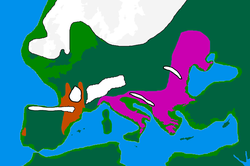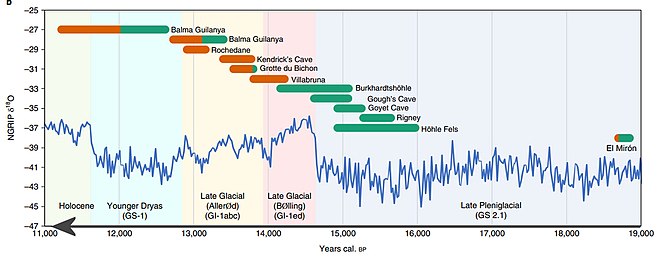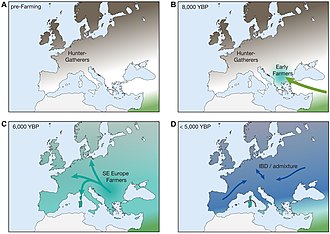Western Hunter-Gatherer
Genetic ancestry of hunter-gatherers in Europe between 14 ka and 9 ka, with the main area of Western Hunter-Gatherers (WHG) in blue. Individual numbers correspond to calibrated sample dates.[1] |
In
Along with the Scandinavian Hunter-Gatherers (SHG) and Eastern Hunter-Gatherers (EHG), the WHGs constituted one of the three main genetic groups in the postglacial period of early Holocene Europe.[3] The border between WHGs and EHGs ran roughly from the lower Danube, northward along the western forests of the Dnieper towards the western Baltic Sea.[2]
SHGs were in turn a nearly equal mix of WHGs and EHGs. Once the main population throughout Europe, the WHGs were largely displaced by successive expansions of
Research
Western Hunter-Gatherers (WHG) are recognised as a distinct ancestral component contributing to the ancestry of most modern
Expansion into continental Europe (14,000 BP)
WHGs themselves are believed to have formed around 14,000 years ago, during the

In a genetic study published in Nature in March 2023, the authors found that the ancestors of the WHGs were populations associated with the Epigravettian culture, which largely replaced populations associated with the Magdalenian culture about 14,000 years ago (the ancestors of the Magdalenian-associated individuals were the populations associated with the western Gravettian, Solutrean and Aurignacian cultures).[11][13] In the study, WHG ancestry is renamed 'Oberkassel ancestry', first found north of the Alps in two 14,000 year-old individuals at the eponymous site at Oberkassel, who can be modeled as an admixture of Villabruna ancestry (itself modeled as an admixture between a lineage related to the Věstonice cluster and a lineage ancestral to the Kostenki-14 and Goyet Q116-1 individuals), and Goyet-Q2 ancestry related to individuals found in Europe prior to the Last Glacial Maximum. The study states that all of the individuals of the Oberkassel cluster could be modeled as c. 75% Villabruna and 25% Goyet-Q2 ancestry or, alternatively, as c. 90% Villabruna and 10% Fournol ancestry, a newly identified cluster described as a sister lineage of the Goyet Q116-1 ancestry found in individuals associated with the Gravettian culture of southwestern Europe.[11] The study suggests that Oberkassel ancestry was mostly already formed before expanding, possibly around the west side of the Alps, to Western and Central Europe and Britain, where sampled WHG individuals are genetically homogeneous. This is in contrast to the arrival of Villabruna and Oberkassel ancestry to Iberia, which seems to have involved repeated admixture events with local populations carrying high levels of Goyet-Q2 ancestry. This, and the survival of specific Y-DNA haplogroup C1 clades previously observed among early European hunter-gatherers, suggests relatively higher genetic continuity in southwest Europe during this period.[11]
There are indications that the WHG carried "risk alleles for diabetes and Alzheimer's disease".[14]

Interaction with other populations

The WHG were also found to have contributed ancestry to populations on the borders of Europe such as early Anatolian farmers and Ancient Northwestern Africans,[16] as well as other European groups such as Eastern Hunter-Gatherers.[17] The relationship of WHGs to the EHGs remains inconclusive.[17] EHGs are modeled to derive varying degrees of ancestry from a WHG-related lineage, ranging from merely 25% to up to 91%, with the remainder being linked to geneflow from Paleolithic Siberians (ANE) and perhaps Caucasus hunter-gatherers. Another lineage known as the Scandinavian Hunter-Gatherers (SHGs) were found to be a mix of EHGs and WHGs.[a][19][20]
People of the Mesolithic
People of the
SHGs have been found to contain a mix of WHG components who had likely migrated into Scandinavia from the south, and EHGs who had later migrated into Scandinavia from the northeast along the

The DNA of eleven WHGs from the
Replacement by Neolithic farmers

A seminal 2014 study first identified the contribution of three main components to modern European lineages: the Western Hunter Gatherers (WHG, in proportions of up to 50% in Northern Europeans), the
This 2014 study found evidence for genetic mixing between WHG and EEF throughout Europe, with the largest contribution of EEF in Mediterranean Europe (especially in Sardinia, Sicily, Malta and among Ashkenazi Jews), and the largest contribution of WHG in Northern Europe and among Basque people.[28]
Since 2014, further studies have refined the picture of interbreeding between EEF and WHG. In a 2017 analysis of 180 ancient DNA datasets of the Chalcolithic and Neolithic periods from Hungary, Germany and Spain, evidence was found of a prolonged period of interbreeding. Admixture took place regionally, from local hunter-gatherer populations, so that populations from the three regions (Germany, Iberia and Hungary) were genetically distinguishable at all stages of the Neolithic period, with a gradually increasing ratio of WHG ancestry of farming populations over time. This suggests that after the initial expansion of early farmers, there were no further long-range migrations substantial enough to homogenize the farming population, and that farming and hunter-gatherer populations existed side by side for many centuries, with ongoing gradual admixture throughout the 5th to 4th millennia BC (rather than a single admixture event on initial contact).[29] Admixture rates varied geographically; in the late Neolithic, WHG ancestry in farmers in Hungary was at around 10%, in Germany around 25% and in Iberia as high as 50%.[30]
Analysis of remains from the Grotta Continenza in
Neolithic individuals in the British Isles were close to Iberian and Central European Early and Middle Neolithic populations, modeled as having about 75% ancestry from EEF with the rest coming from WHG in continental Europe. They subsequently replaced most of the WHG population in the British Isles without mixing much with them.[34]
The WHG are estimated to have contributed between 20-30% ancestry to Neolithic EEF groups throughout Europe. Specific adaptions against local pathogens may have been introduced via the Mesolithic WHG admixture into Neolithic EEF populations.[35]
A study on Mesolithic hunter-gatherers from
Physical appearance

According to
Archaeologist Graeme Warren has said that their skin color ranged from olive to black, and speculated that they may have had some regional variety of eye and hair colors.[41] This is strikingly different from the distantly related Eastern Hunter-Gatherers (EHG)—who have been suggested to be light-skinned, brown-eyed or blue eyed and dark-haired or light-haired.[42]
Two WHG skeletons with incomplete SNPs, La Braña and Cheddar Man, are predicted to have had dark or dark to black skin, whereas two other WHG skeletons with complete SNPs, "Sven" and Loschbour man, are predicted to have had dark or intermediate-to-dark and intermediate skin, respectively.[43][24][b] Spanish biologist Carles Lalueza-Fox said the La Braña-1 individual had dark skin, "although we cannot know the exact shade."[45]
According to a 2020 study, the arrival of Early European Farmers (EEFs) from western Anatolia from 8500 to 5000 years ago, along with Western Steppe Herders during the Bronze Age, caused a rapid evolution of European populations towards lighter skin and hair.[40] Admixture between hunter-gatherer and agriculturist populations was apparently occasional, but not extensive.[46]

Some authors have expressed caution regarding skin pigmentation reconstructions: Quillen et al. (2019) acknowledge studies that generally show that "lighter skin color was uncommon across much of Europe during the Mesolithic", including studies regarding the “dark or dark to black” predictions for the Cheddar Man, but warn that "reconstructions of Mesolithic and Neolithic pigmentation phenotype using loci common in modern populations should be interpreted with some caution, as it is possible that other as yet unexamined loci may have also influenced phenotype."[47]
Geneticist Susan Walsh at
A 2024 research into the genomic ancestry and social dynamics of the last hunter-gatherers of Atlantic France has stated that "phenotypically, we find some diversity during the Late Mesolithic in France", at which two of the WHG's sequenced in the study "likely had pale to intermediate skin pigmentation", but "most individuals carry the dark skin and blue eyes characteristic of WHGs" of the studied samples.[50]
Notes
- ^ Eastern Hunter Gatherers (EHG) derive 3/4 of their ancestry from the ANE... Scandinavian hunter-gatherers (SHG) are a mix of EHG and WHG; and WHG are a mix of EHG and the Upper Paleolithic Bichon from Switzerland.[18]
- ^ These predictions were obtained using a multinomial logistic regression model based on a panel of 36 carefully selected SNPs with a low sensitivity of 0.26 for classifying intermediate skin (compared to 0.99 and 0.90 for white and black skin, respectively). The accuracy of the model used could be further improved with "additional (but currently unknown) SNP predictors once identified via future GWAS".[44]
References
- S2CID 257259969.
- ^ a b Anthony 2019b, p. 28.
- ^ Kashuba 2019: "Earlier aDNA studies suggest the presence of three genetic groups in early postglacial Europe: Western hunter–gatherers (WHG), Eastern hunter–gatherers (EHG), and Scandinavian hunter–gatherers (SHG)4. The SHG have been modelled as a mixture of WHG and EHG."
- PMID 36963383.
- ^ a b c Lazaridis 2014.
- ^ Mathieson 2015.
- ^ Haak 2015.
- PMID 27135931.
Beginning with the Villabruna Cluster at least ~14,000 years ago, all European individuals analyzed show an affinity to the Near East. This correlates in time to the Bølling-Allerød interstadial, the first significant warming period after the Ice Age. Archaeologically, it correlates with cultural transitions within the Epigravettian in Southern Europe and the Magdalenian-to-Azilian transition in Western Europe. Thus, the appearance of the Villabruna Cluster may reflect migrations or population shifts within Europe at the end of the Ice Age, an observation that is also consistent with the evidence of turnover of mitochondrial DNA sequences at this time. One scenario that could explain these patterns is a population expansion from southeastern European or west Asian refugia after the Ice Age, drawing together the genetic ancestry of Europe and the Near East. Sixth, within the Villabruna Cluster, some, but not all, individuals have affinity to East Asians. An important direction for future work is to generate similar ancient DNA data from southeastern Europe and the Near East to arrive at a more complete picture of the Upper Paleolithic population history of western Eurasia
- S2CID 174809069.
- ^ Vallini et al. 2022 (4 July 2022). "Genetics and Material Culture Support Repeated Expansions into Paleolithic Eurasia from a Population Hub Out of Africa". Retrieved 16 April 2023.
{{cite web}}: CS1 maint: numeric names: authors list (link) - ^ PMID 36859578.)
{{cite journal}}: CS1 maint: multiple names: authors list (link - PMID 23145109.
Through this analysis we identified a chromosome from southern Europe as a new deep branch within haplogroup C (C-V20 or C7, Figure S1). Previously, only a few examples of C chromosomes (only defined by the marker RPS4Y711) had been found in southern Europe [32], [33]. To improve our knowledge regarding the distribution of haplogroup C in Europe, we surveyed 1965 European subjects for the mutation RPS4Y711 and identified one additional haplogroup C chromosome from southern Europe, which has also been classified as C7 (data not shown).
- ^ "Scientists Sequence Genomes of Prehistoric Hunter-Gatherers from Different Eurasian Cultures". Sci.News. 2 March 2023.
- PMID 38200293.
... whereas risk alleles for diabetes and Alzheimer's disease are enriched for Western hunter-gatherer ancestry.
- PMID 36280785.
- PMID 37286608.
- ^ S2CID 19158377.
- ^ Lazaridis 2016.
- PMID 25731166.
- S2CID 174809069.
- ^ a b Mittnik 2018.
- ^ Jones 2017.
- ^ Saag 2017.
- ^ a b Günther 2018.
- ^ a b c d e Mathieson 2018.
- PMID 24809476.
- PMID 25230663.
Most present-day Europeans derive from at least three highly differentiated populations: west European hunter-gatherers, who contributed ancestry to all Europeans but not to Near Easterners; ancient north Eurasians related to Upper Palaeolithic Siberians, who contributed to both Europeans and Near Easterners; and early European farmers, who were mainly of Near Eastern origin but also harboured west European hunter-gatherer related ancestry.
- ^ Lazaridis et al. (2014), Supplementary Information, p. 113.
- .
- ^ Lipson et al. (2017), Fig 2.
- ^ Antonio et al. 2019, Table 2 Sample Information, Rows 4-6.
- ^ Antonio et al. 2019, p. 1.
- ^ Antonio et al. 2019, p. 2, Fig. 1.
- PMID 30988490.
- PMID 36963383.
- PMID 38200294.
- ISBN 978-1-000-47515-9.
- ^ Details on the reconstruction from the Natural History Museum: "Cheddar Man: Mesolithic Britain's blue-eyed boy". www.nhm.ac.uk. Natural History Museum.
- ISBN 978-1101870334. "Analysis of ancient DNA data shows that the hunter-gatherers of Western Europe some eight thousand years ago had blue eyes but dark skin and dark hair, a combination that is rare today."
- ^ S2CID 220335539.
Homo sapiens arrrived in Europe from Near East some 42 000 years ago. Like in their African origin, these humans had dark skin but due to variations of their OCA2 gene (causing iris depigmentation) many of them had blue eyes" (...) "southern and central Europe, where they [light skin alleles] were introduced by farmers from western Anatolia expanding 8500 to 5000 years ago. This was the start of the Neolithic revolution in these regions, characterized by a more sedentary lifestyle and the domestication of certain animal and plant species. (...) "The rapid increase in population size due to the Neolithic revolution, such as the use of milk products as food source for adults and the rise of agriculture, as well as the massive spread of Yamnaya pastoralists likely caused the rapid selective sweep in European populations towards light skin and hair
- ISBN 978-1789256840. "WHGs for example, had skin pigmentation ranging from olive to brown to black, with blue or blue-green eyes. In some parts of Europe this may also have been associated with blond hair."
- PMID 30988490 Supplementary Material. Page 22: "Two WHGs (Cheddar Man and La Braña from northern Spain) are predicted to have had dark or dark-to-black skin, whereas one (Loschbour44from Luxembourg) is predicted to have had intermediate skin suggesting but we find potential temporal and/or geographical variation in pigmentation characteristics, suggesting that diverse skin pigmentation levels coexisted in WHGs by at least ca.8 kBP. Sven was predicted to have had dark to intermediate to dark skin in line with the current hypothesis that alleles commonly associated with lighter skin in Europeans were introduced to north-western Europe by ANFs."
- PMID 28500464.
- ^ "Dark Skin, Blue Eyes: Genes Paint 7,000-Year-Old European's Picture". NBC News. 26 January 2014.
- S2CID 248765487.
Once established in Anatolia, Excoffier's team found, early farming populations moved west into Europe in a stepping-stone-like fashion, beginning around 8,000 years ago. They mixed occasionally — but not extensively — with local hunter-gatherers.
- S2CID 53237190.
Their analyses suggest that the skin color of both individuals was likely dark, with that of Mesolithic Cheddar Man predicted to be "dark or dark to black". These findings suggest that lighter skin color was uncommon across much of Europe during the Mesolithic. This is not, however, in conflict with the date estimates of <20 kya above, which addresses the onset of selection and not time of fixation of favored alleles (Beleza et al., 2013; Beleza, Johnson, et al., 2013). While ancient genome studies predict generally darker skin color among Mesolithic Europeans, derived alleles at rs1426654 and rs16891982 were segregating in European populations during the Mesolithic (González-Fortes et al., 2017; Günther et al., 2018; Mittnik et al., 2018), suggesting that phenotypic variation due to these loci was likely present by this time. However, reconstructions of Mesolithic and Neolithic pigmentation phenotype using loci common in modern populations should be interpreted with some caution, as it is possible that other as yet unexamined loci may have also influenced phenotype.
- ^ "Ancient 'dark skinned' Cheddar man find may not be true". New Scientist. 21 February 2018.
- ISBN 9780593229446.
- PMID 38408241.
Bibliography
- ISBN 978-9004416192.
- Antonio, Margaret L.; et al. (8 November 2019). "Ancient Rome: A genetic crossroads of Europe and the Mediterranean". PMID 31699931.
- Günther, Thorsten (1 January 2018). "Population genomics of Mesolithic Scandinavia: Investigating early postglacial migration routes and high-latitude adaptation". PMID 29315301.
- Haak, Wolfgang (11 June 2015). "Massive migration from the steppe was a source for Indo-European languages in Europe". PMID 25731166.
- Jones, Eppie R. (20 February 2017). "The Neolithic Transition in the Baltic Was Not Driven by Admixture with Early European Farmers". PMID 28162894.
- Kashuba, Natalija (15 May 2019). "Ancient DNA from mastics solidifies connection between material culture and genetics of mesolithic hunter–gatherers in Scandinavia". Communications Biology. 2 (105). PMID 31123709.
- Lazaridis, Iosif (17 September 2014). "Ancient human genomes suggest three ancestral populations for present-day Europeans". PMID 25230663.
- Lazaridis, Iosif (25 July 2016). "Genomic insights into the origin of farming in the ancient Near East". PMID 27459054.
- Mathieson, Iain (23 November 2015). "Genome-wide patterns of selection in 230 ancient Eurasians". PMID 26595274.
- Mathieson, Iain (21 February 2018). "The Genomic History of Southeastern Europe". PMID 29466330.
- Mittnik, Alisa (30 January 2018). "The genetic prehistory of the Baltic Sea region". PMID 29382937.
- Saag, Lehti (24 July 2017). "Extensive Farming in Estonia Started through a Sex-Biased Migration from the Steppe". PMID 28712569.
Further reading
- Anthony, David (Spring–Summer 2019). "Archaeology, Genetics, and Language in the Steppes: A Comment on Bomhard". Journal of Indo-European Studies. 47 (1–2). Retrieved 9 January 2020.
- Lazaridis, Iosif (December 2018). "The evolutionary history of human populations in Europe". S2CID 19158377. Retrieved 15 July 2020.

